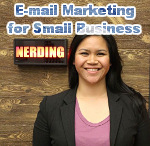E-mail Marketing for Small Business

Guest author Angie Picardo, staff writer for NerdWallet.com
E-mail marketing offers a larger reach in audience at a low cost to small businesses. E-mail marketing also provides small businesses with the ability to communicate instantly with potential customers and clients, while simultaneously driving traffic to the business website. Information received through e-mail can also help businesses understand the needs and desires of prospective customers without having to employ expensive research, trial and error, and learning from long term mistakes.
While there are many great advantages to e-mail marketing (↑), there are a few things business owners should know before fully embracing this type of marketing.
Don’t become a spammer – First and foremost, do not send out constant e-mail blasts to your customer mailing list or spam networks that might potentially attract new clients. Unless there is a good reason for your business to communicate with customers on a weekly basis, anything more than a couple of e-mail blasts each month is probably too much. No customer likes receiving a large amount of junk mail, and if you inundate them with ads, promotions, and other communication, they will ignore you at best or choose a competitor at worst.
Distinguish yourself – Consumers sign up for e-mail lists and marketing promotion updates all the time. Some consumers will spend the first part of their morning deleting 20-30 spam e-mails and other promotions they simply do not have the time or care for. Part of this has to do with the content in the subject line (the first thing a customer will generally read before opening an e-mail), while other consumers are simply tired of receiving the same old, lame product promotions that seem too good to be true (and generally are) before reading the fine print. Savvy e-mail marketers will know who their audience and target markets are, approach them accordingly, and distinguish themselves from other companies (even those who are not competitors) that also send out constant, bulky e-mail ads.
Get Legit – Make sure that when you send out advertising and promotions they are sent from your site’s domain name. Sending e-mails to prospective clients from a Gmail or Yahoo! Mail account looks unprofessional, so sending mail out from a legitimate e-mail domain account will enhance your credibility. Correspondence sent from credit domains will be noticed by prospective customers and will statistically increase your chances for making a sale.
Know your marketing – When marketing via e-mail, it is important that you stay consistent with your other marketing campaigns. Further, it wise to have a firm grasp of who you are targeting and what they require. Having solid experience in marketing will benefit you here, but for those who are new to such an endeavor should read up and get as much research under their belt as possible. Watching the behavior of your competitors can be beneficial, and noticing the types of e-mail marketing you receive as a consumer can help you learn what to do (and what not to do).
Be easy on your customers – If you make it easy to subscribe, you will significantly enhance the amount of people that will sign up for e-mail notifications and announcements. Posting a subtle hyperlink on your website, blog, or Facebook page will allow customers a quick and easy medium to subscribe for your e-mail notifications.
Edit – There’s not much to say here; be grammatically correct, succinct, and precise with what you want to say to customers.
Share – Any e-mail you send out to a prospective customer is shareable, but making content on your website sharable is a great, indirect e-mail marketing strategy. By making content e-mail-able, customers will do the e-mail marketing for you. If you create a page or post a blog that is newsworthy or of which becomes highly acclaimed, visitors to your site can e-mail each other the content. This not only promotes your website, product, or service, but helps increase your traffic as well.
_______________
Angie Picardo is a staff writer for NerdWallet. Her mission is to help consumers stay financially savvy, and save some money with the best online savings accounts. (↑)
